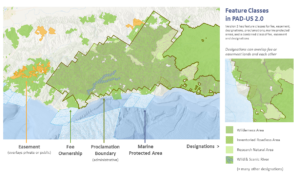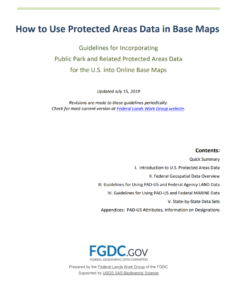Version 3.0
Version 3.0 of the Protected Areas Database of the United States (PAD-US) has been released. Data is available for download nationally, by 12 Department of the Interior (DOI) regions, or 56 State/Territory boundaries. The data is provided in several file types including geodatabase, shapefile, geopackage, GeoJSON, or KMZ.
U.S. Geological Survey (USGS) Gap Analysis Project (GAP), 2022, Protected Areas Database of the United States (PAD-US) 3.0: U.S. Geological Survey data release, https://doi.org/10.5066/P9Q9LQ4B.
PAD-US Data Explorer
USGS launched the Protected Areas Database of the United States (PAD-US) Data Explorer. This online map application allows users to view web maps and chart statistics of areas that are protected for biodiversity conservation, as well as lands and waters that provide public access to nature.
PAD-US Statistics Dashboard
USGS is providing a PAD-US Statistics Dashboard. This dashboard provides a way of interacting with PAD-US data by leveraging spatial data from PAD-US into tabular and chart format. It enables users to quickly visualize information from acreage to ownership and landscape composition in an accessible format at a (coarse) national scale all the way down to a (granular) county scale.
Poster Maps
PAD-US 3.0 poster maps are available to increase awareness of PAD-US and aid user interpretation. The maps provide a general overview of management, not ownership, as Federal and other designated areas may overlap state, private, and other inholdings. The maps include U.S. States only (not Territories) based on the PAD-US 3.0 Combined Proclamation (Tribal areas and military lands are provided for context), Marine, Fee, Designation, Easement feature class, published by the USGS Science Analytics and Synthesis (SAS), Gap Analysis Project (GAP).
GAP Status Assignment Tool
An online tool that allows PAD-US Data Stewards to determine GAP Status Code for a protected area is now available. GAP Status Codes are a measure of the conservation type of each parcel based on protection level categories that provide a measure of management intent for the long-term protection of biodiversity. User provided GAP Status Codes are preferred but can be categorically assigned using designation type and a crosswalk created in collaboration with data stewards.
Read more
